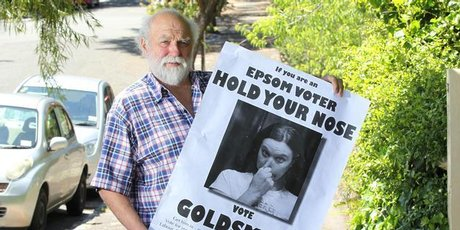Graduatedly preferentially fixing fixed threshold

Minister of Motorways: ‘But these tires were guaranteed to be recession-proof!’ Prime Moneytrader: ‘Just get those wheels back on—this is still the quickest route to economic Nirvana.’ cartoon Majorlook Productions
The two things are tied together.
The coattails provision and the 5% threshold, in New Zealand’s implementation of mixed member proportional. But first, it is necessary to consider why either might be necessary.
Mixed member proportional is designed to ensure that political parties are represented in as close to their exact proportion as practicable, in the interests of basic fairness. The other way of stating that is that all votes should be treated as equally. The Royal Commission on the Electoral System, commenting on this aspect of the 1981 election held under first-past-the-post five years earlier, pointed out that:
In effect it took an average of 186 000 votes to elect each Social Credit MP whereas National won 1 seat on average for every 14 900 votes received, and Labour 1 seat for every 16 300 votes.
Having determined that proportionality was a cardinal requirement of a fair voting system, the royal commission recommended:
The only significant deviation from full proportionality in the MMP system proposed for New Zealand is in the imposition of the 4% threshold. The Commission considers that the threshold is a justifiable and desirable means of preventing the proliferation of minor parties in the House. Such a proliferation could threaten the stability and effectiveness of government.
Although Germany, whose system their recommendations were modelled on, had a threshold of 5%, the commission believed Aotearoa’s should be a slightly less precautionary 4%, which also happens to be the current Parliamentary Assembly of the Council of Europe recommendation. Be that as it may, when mixed member proportional was implemented, the National government went with 5%, which is the threshold used by most countries with proportional systems since.
The reason to set thresholds as low as practicable is that votes for parties that fail to reach threshold are wasted. The percentage of wasted, or unrepresented, votes can be considerable—45% in the case of the 1995 Russian parliamentary elections, where the threshold likewise is 5%. Of course, wasting of votes can be intentional and legitimate, such as by voting for an entirely factious party where the intention is to register a vote of no confidence in the system. That aside, there is an entirely straightforward means of preventing the waste of votes cast for parties that fail to reach the threshold: Allow voters to rank their subsequent party preference, or preferences, rather than be permitted to tick only their first preference. This would see that the second preference of an Alliance supporter, for example, went to a party that succeeded in being represented. Further, it also would ensure that the significant number of Green Party supporters, for example, who express their preference for Labour over National by voting for the Green electorate candidate but give their party tick to Labour, don’t continue to repeat that basic error.
That leaves the curious coattails provision. It is difficult to divine why the German system ever included a coattails provision and why the commission believed it should be emulated by Aotearoa. The commission possibly believed it would differentiate between the sorts of idiosyncratic splinter parties that plague Israeli politics and those that could attract serious, albeit localised, support. In fairness to the commission, their studies of mixed member proportional implementations probably failed to expose a situation where a major party was prepared to consistently game the system to the shameful extent that has occurred in the Epsom electorate.

Fixing the Fixed Match: Renowned potter Peter Lange’s answer to the ActNational attempt to rort Aotearoa’s serially abused electoral coattails provision. photographer Paul Estcourt New Zealand Herald
Few proportional systems have a coattails provision and there is little doubt that an Electoral Commission review, if one is held, would see it off—Prime Minister John Key would no doubt be relieved to see the back of it, his unseemly and unnecessary involvement on Friday causing him his the greatest embarrassment to date. Peter Lange, whose charisma is considerable even by the standards of his revered brother’s memory, had earlier highlighted the sham by asking National’s candidate Paul Goldsmith directly whether he wanted to be the member for Epsom. When Goldsmith gave a predictably ‘clever’ answer, Lange countered:
I’m sorry you can’t answer straight. I am going to vote for you anyway, hold my nose, and do it. We should all do it and kick him into parliament and Epsom will be cleansed [of the Act Party].
But irrespective of Act’s particular odiousness, it is legitimate that minor parties be proportionately represented, and the only reason some small parties have proved so problematic is that Labour and National have allowed them to hold the balance of power. Those two dominant centrist parties could have readily called the bluff of the extortionists by forming a coalition, were they not mindlessly wedded to an adversarial mindset that predates proportional government.
A further refinement that an Electoral Commission review should consider is the ‘graduated threshold’. Devised by Stephen Todd, the man responsible for the first successful computerised means of allocating single transferable votes, it is an elegant alternative to the arbitrary 5% threshold. At say 3% a party would be allocated one seat. The allocation then increases more steeply the closer a party polls to (say) 5%. At and above that percentage, the party would receive full proportionality. The effect is to remove the sudden death, whereby a party can go from six seats to none, the instant support drops below 5%.
If Aotearoa votes to retain mixed member proportional, its coattails provision will be gone by 2014.
Update Despite the Electoral Commission review recommendations that the one-seat threshold for representation be abolished and the 5% threshold be lowered to 4, the National-led government shamelessly refused to make good on its promise to tweak the system, benefitting as it does from the Epsom gerrymander.
